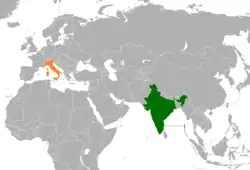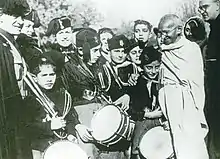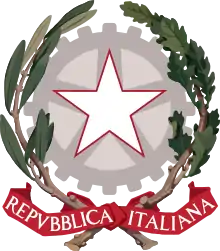India–Italy relations
India–Italy relations refers to the international relations that exist between India and Italy. India maintains an Embassy in Rome, and a Consulate-General in Milan. Italy has an embassy in New Delhi, and Consulate-Generals in Mumbai and Kolkata. The relations are characterized by warmth and friendship.
 | |
India |
Italy |
|---|---|
| Diplomatic mission | |
| Embassy of India, Rome | Embassy of Italy, New Delhi |
| Envoy | |
| Indian Ambassador to Italy Reenat Sandhu | Italian Ambassador to India Vincenzo de Luca |
Early history
Indo-Roman relations

Relations between India and Italy date back to ancient times. Works from authors such as Diodorus Siculus' Library of History, Arrian's Indika, and Pliny the Elder's Natural History make references to India. Trade links flourished between India and the Roman Empire, particularly in the first and second century AD. Caches of Roman coins have been discovered across the Indian peninsula, and evidence indicates the existence of permanent settlements of Roman merchants in South India. The discovery of an Indian ivory statuette in the ruins of Pompeii confirms that goods were traded both ways. The Roman Empire and Indian civilizations also exchanged diplomatic missions. An Indian embassy sailed from Bharuch (referred to as Barygaza by the Romans) in 25 BC and arrived in Rome four years later. Records also exist of Indian embassies being sent to Trajan, Antoninus Pius, Julian the Apostate and Justinian.[1]
Middle Ages
Relations and trade between the Mediterranean and India ended after the fall of the Roman Empire, but resumed after a few centuries. In the Middle Ages, Italian merchants once again began to ply the old routes towards the east used by the Romans. The most notable among these merchants was Marco Polo, who visited south-east India and ports such as Kayak, Comorin (now Kanyakumari), Quilon (now Kollam), Thana, Somnath and Cambay. Marco Polo published his travelogue The Travels of Marco Polo in which he described the life and customs in India at the end of the 13th century.[1]
Many other notable Venetians also visited India. Niccolò de' Conti left Venice in 1419 to visit the Middle East, Persia and then India. Conti traversed the Indian peninsula from coast to coast, and also moved inland to Vijayanagara. Cesare Federici set sail from Venice in 1563 towards the east. He visited Vijayanagara and the present-day state of Kerala, documenting his travels in Viaggio nell'India Orientale et oltra l'India nel quale si contengono cose dilettevoli, 1587. Venetian merchant and jeweler, Gasparo Balbi visited Persia and India in 1579–88, publishing his experiences in Viaggio dell'Indie Orientali, di Gasparo Balbi, Gioielliero Venetiano, 1590. Ambrosio Bembo travelled from Venice in 1671 and spent four years visiting the Middle East, India and Persia. He documented his visits to Goa and Bombay (now Mumbai) in his journal Viaggio e giornale per parte dell'Asia di quattro anni circa fatto da me Ambrosio Bembo, Nobile Veneto. Nicolo Manucci left Venice at the age of fourteen and headed to India. He served the Mughal Empire and later died in India. Manucci's Storia do Mogor is among the most detailed histories of the Mughal Empire (in the period 1653-1708) written by a contemporary European observer.[1]
Visitors also came from other regions of Italy. Filippo Sassetti, a scholar and humanist from Florence, also visited India. He died in Goa in 1588. Sassetti wrote several letters in which he noted similarities between Sanskrit and Italian. Pietro della Valle from Rome arrived in India in 1624, where he visited Surat, Goa and Keladi. He published Travels in Persia and India between 1658 and 1663. Giovanni Francesco Gemelli Careri, a lawyer from Naples, visited South India during a trip around the world he had begun 1693. Gemelli Careri provides a detailed description of the camp of Mughal emperor Aurangzeb during the Deccan campaign in 1695, in Giro Intorno al Mondo, published in 1699. Many other Italians have also visited India and their names are mentioned on old chronicles. Apart from merchants and travelers, Italians also served in other roles in India such as physicians and artillerymen. Italian Jean-Baptiste Ventura contributed to the organization of the infantry in the army of Ranjit Singh in the 1830s and 40s.[1]
British Raj
During the British Raj, trade and travel between India and Italy reduced significantly due to prevailing political conditions. Italian scholars participated in Sanskrit studies, and Gaspare Gorresio created the first Chair of Sanskrit in Italy at the University of Turin in 1852. Gorresio translated the Ramayana into Italian. It was published as Ramayana, poema indiano di Valmichi in ten volumes between 1843 and 1858. The Italian unification movement inspired some Indian freedom fighters, and the works of the Italian patriot Giuseppe Mazzini were translated and widely read by Indian intelligentsia.[1]

Mahatma Gandhi accepted an invitation to visit Rome in December 1931 and meet then-Prime Minister Benito Mussolini.[2] Mussolini hailed Gandhi as a "genius and a saint" and admired his ability to challenge the British Empire. After his visit, Gandhi wrote a letter to a friend stating, "Mussolini is a riddle to me. Many of his reforms attract me. He seems to have done much for the peasant class. I admit an iron hand is there. But as violence is the basis of Western society, Mussolini's reforms deserve an impartial study ... What strikes me is that behind Mussolini's implacability is a desire to serve his people. Even behind his emphatic speeches there is a nucleus of sincerity and of passionate love for his people. It seems to me that the majority of the Italian people love the iron government of Mussolini." Gandhi also hailed Mussolini as the “one of the great statesmen of our time." However, by the time Italy invaded Abyssinia in 1935, Gandhi disavowed Mussolini.[3]
In the 1940s, during World War II, the British brought Italian prisoners of war, who were captured in either Europe or North Africa, to Bangalore and Madras. They were put up at the Garrison Grounds, today's Parade Grounds-Cubbon Road area.[4] In February 1941, about 2,200 Italian prisoners of war arrived in Bangalore by a special train and were marched to internment camps at Byramangala, 20 miles from Bangalore.[5]
Indian forces played a role in liberating Italy from Nazi control. India contributed the 3rd largest Allied contingent in the Italian campaign after US and British forces. The 4th, 8th and 10th Divisions and 43rd Gurkha Infantry Brigade led the advance, notably at the gruelling Battle of Monte Cassino.
Modern history
Diplomatic relations between the Republic of India and the Italian Republic were established in 1947. Indian Prime Minister Jawaharlal Nehru visited Italy in 1953. President Oscar Luigi Scalfaro was the first Italian head of state to visit India in February 1995. President Carlo Azeglio Ciampi visited India in February 2005.[4]
Romano Prodi became the first Italian Prime Minister to visit India in February 2007. Indian Prime Minister Manmohan Singh visited Italy to attend the 35th G8 summit at L'Aquila in July 2009. External Affairs Minister S.M. Krishna represented India at the 150th anniversary celebrations of the Unification of Italy in Rome In June 2011.[5]
After some years of tensions due to the case of the two Italian marines accused of killing two fishermen off the coast of Kerala, the two countries revived normal relations thanks to Prime Ministers Paolo Gentiloni and Narendra Modi.[6] The two leaders described Gentiloni's visit in India in 2017 as a "new beginning" and a great opportunity for both countries.[7]
Economic relations
Bilateral trade
Bilateral trade between India and Italy grew by 12 times in the 2 decades between 1991 and 2011, from EUR 708 million to EUR 8.5 billion. Bilateral trade began experiencing a decline from 2012, decreasing to €7.1 billion in 2012 and €6.95 billion in 2013.[8]
On November 29, 2017, India and Italy signed a memorandum of understanding (MoU) for enhancing bilateral cooperation in the health sector. This MoU was signed between Union Health Minister J P Nadda and the visiting Italian Health Minister Beatrice Lorenzin. The MoU envisages cooperation in health sector by pooling in technical, financial and human resources for accomplishing the ultimate objective to upgrade infrastructural resources, medical education and research in both countries. Activities to be carried out under the scope of this MoU include exchange and training of doctors, setting up of health care facilities and promotion of business development opportunities in pharmaceuticals.
Foreign direct investment
Italian companies invested €694 million in India in 2011, and over €1 billion in 2012. As of December 2012, Italy had an accumulated investment of €3.75 billion in India, or 9% of the total European Union FDI in India.[8]
Indian investment in Italy grew from €584 million in 2004 to €10 billion in 2011. Italy accounted for 2.3% of India's total investment in the European Union.[8]
References
- "Storia". www.ambnewdelhi.esteri.it. Retrieved 2016-10-08.
- "Indo-Italian Cultural Relations". www.indianembassyrome.in. Retrieved 8 October 2016.
- "Mussolini and Gandhi: Strange Bedfellows". International Business Times. 2012-03-03. Retrieved 2016-10-08.
- "India-Italy High Level Visits". www.indianembassyrome.in. Retrieved 2016-10-08.
- "India-Italy Political Relations". www.indianembassyrome.in. Retrieved 2016-10-08.
- India can become a key market for Italian machinery makers
- Paolo Gentiloni in India, vertice con il premier Modi: "Grande opportunità di rilancio"
- "Economic Cooperation". www.ambnewdelhi.esteri.it. Retrieved 8 October 2016.
Further reading
- Meenakshi Jain, The India They Saw : Foreign accounts (co-edited with Sandhya Jain, 4 Volumes, Prabhat Prakashan), ISBN 8184301065, ISBN 8184301073, ISBN 8184301081, ISBN 818430109X.
- Majumdar, R. C. (1981). The Classical accounts of India: Being a compilation of the English translations of the accounts left by Herodotus, Megasthenes, Arrian, Strabo, Quintus, Diodorus, Siculus, Justin, Plutarch, Frontinus, Nearchus, Apollonius, Pliny, Ptolemy, Aelian, and others with maps. Calcutta: Firma KLM.
External links
| Wikimedia Commons has media related to Relations of India and Italy. |
